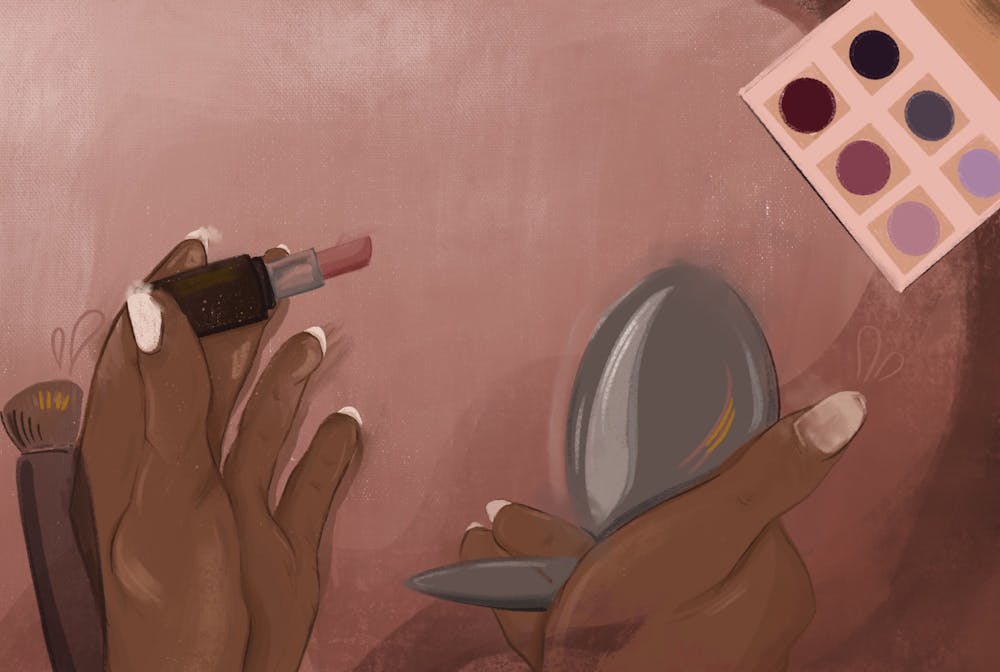My first thought upon entering Brandy Melville’s Walnut Street location was that I was wading into some sort of fever dream set in 1990s California. The bleached wood and white–walled interiors envelop the store in a kind of permanent VSCO filter; muted pastel tones evoke grainy visuals of the beach and the sea. Sweatshirts emblazoned with the monikers of varying West Coast locations line the walls, coupled with dainty skirts and slim tanks carrying embroidered floral motifs.
The store capitalizes upon the brand’s primary aesthetic: an All-American teen girl encapsulated in a summery, retro-filtered persona.

Despite the homage to Californian style and imagery, Brandy Melville was originally founded in Italy, by a retailer named Silvio Marsan. Since the establishment of the first US branch on a UCLA campus in 2009, the brand has become one of the fastest growing amongst teenage girls. Brandy Melville has earned notoriety for selling the quintessential 90s aesthetic—plaid skirts, graphic tees, and grommet belts—as essential closet staples. The brand’s catalog delivers the romanticized, sought–after image of thrifted vintage clothing, featuring pieces that channel design elements from films like Clueless and She’s All That.
However, the brand’s target demographic remains confined to a relatively narrow realm. Brandy Melville’s controversial 'one size fits most’ policy is one of the prominent indicators of such a consumer base. To be able to fit into a pair of their skinny jeans, for instance, one would need to be a size 0 or 2. The store’s Instagram account conforms to this imagery—a cursory look at their feed reveals absolute homogeneity in the models representing the brand. They are unanimously slender and mostly white. I scrolled through 54 images before I found the first image of a person of color wearing their clothing.
These criticisms, however, are not novel. Brandy Melville has been mired in controversy extending far beyond the aesthetic it promotes, including allegations of discriminatory hiring practices, racist and fat-phobic behavior, and a subsidy brand bizarrely named after a character in an Ayn Rand novel. However, given the exclusivity of Brandy Melville’s carefully curated aesthetic, customers have to buy into extremely selective branding when trying to adopt the image the brand promotes.
Even from a purely aesthetic standpoint, Brandy Melville decries exclusivity. It is not intended for everyone. Despite pressure to diversify its image, Brandy Melville has remained stagnant. This level of inertia, ironically, seems in keeping with the brand's persona—a teenage girl trapped in a perpetual, purgatory–esque state of summer. Much like that particular visual, there seems to be no innate substance to the brand itself.
In short, Brandy Melville sells a hyper—specific image. Of course, it could be argued that most brands partake in the same practice. The products they sell are advertised as helping the consumer achieve that particular image. However, very few brands partake in the same level of exclusionary branding as Brandy Melville and still manage to maintain a youthful customer base.
In an era of social consciousness, I find that more and more brands have, rightfully, prioritized diversity in marketing their image. Glossier, a skincare and beauty brand founded in 2010, markets to the same, millennial audience that Brandy Melville caters to. Developed by Emily Weiss, Glossier's aesthetic is a confectionary of pale pink, bubble wrap bags, clean fonts, and chic designs, which an essential element of its success. However, Weiss credits the 'democratization' of beauty as being core to the brand's popularity— Glossier markets its products as elevating the preexisting beauty of its consumers. The brand emphasizes the diversity of its consumer base, as well as elucidating upon the way the products work on an ethnically and racially varied range of individuals. It seems to be the exact antithesis of Brandy Melville—whereas the former languishes in an image defined by hyper specificity, the latter emphasizes the broad spectrum of its aesthetic.
Despite the popularity of cancel culture, as well as the definite need to hold brands accountable—stores such as Brandy Melville continue to amass popularity. Given the lack of social responsibility the company demonstrates, as well as a propensity towards controversy, it would seem that the primary appeal of the brand lies in the aesthetic it markets. However, given the importance of representation and diversity within fashion, it seems important that we stop buying into the facade of hyper–exclusive brand imagery. Moreover, it feels necessary that we rethink the need for such branding altogether, and strive to create our own definitions of personal beauty rather than buy into restrictive ones curated for us.

